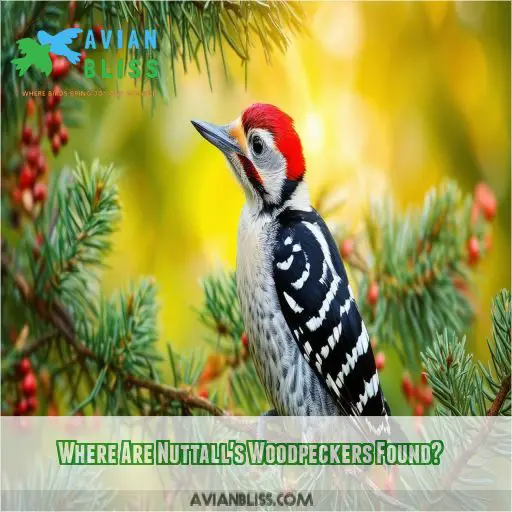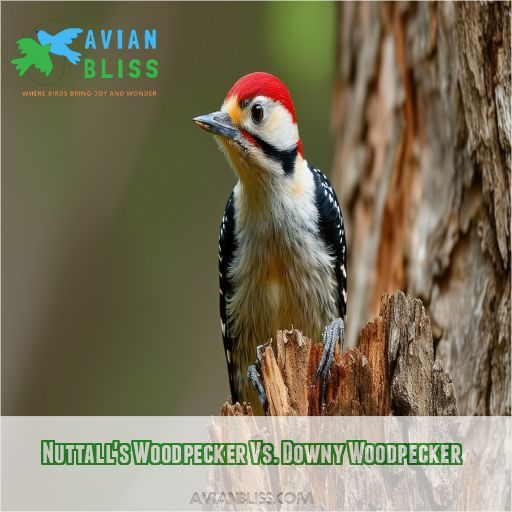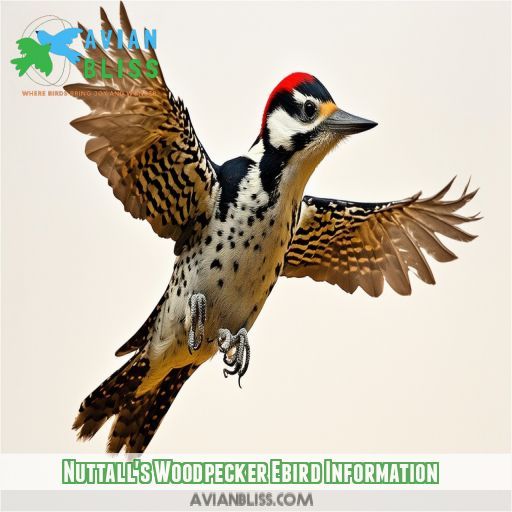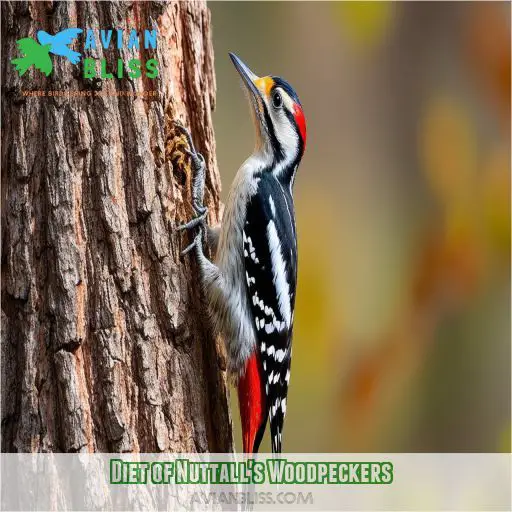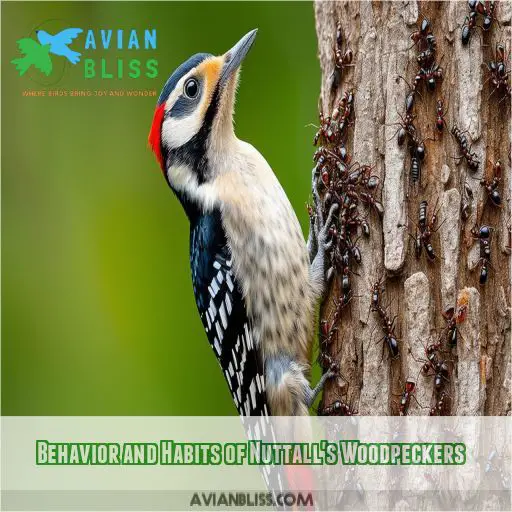This site is supported by our readers. We may earn a commission, at no cost to you, if you purchase through links.
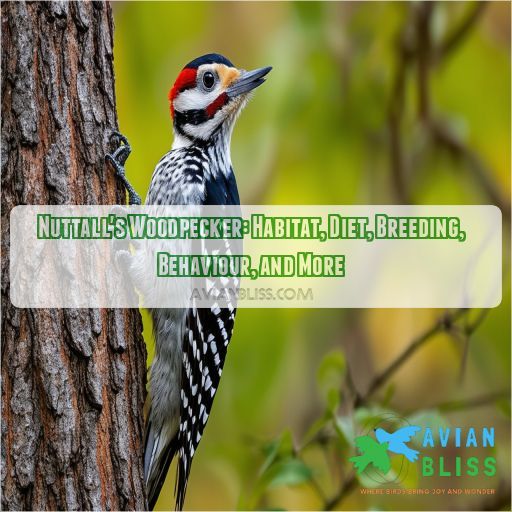
Learn to distinguish these small, black-and-white barred birds from their downy cousins, and explore their distinctive calls and sounds.
We’ll explore their nesting habits, lifespan, and survival strategies against predators.
Master the art of identifying these agile birds and gain insight into their sleeping patterns.
Unravel the secrets of Nuttall’s woodpeckers and enhance your birding expertise.
Table Of Contents
- Key Takeaways
- Where Are Nuttall’s Woodpeckers Found?
- Nuttall’s Woodpecker Vs. Downy Woodpecker
- Wingspan of Nuttall’s Woodpecker
- Nuttall’s Woodpecker Ebird Information
- Nuttall’s Woodpecker Size
- Calls & Sounds of Nuttall’s Woodpeckers
- Diet of Nuttall’s Woodpeckers
- Nesting & Breeding Habits of Nuttall’s Woodpeckers
- Lifespan & Predators of Nuttall’s Woodpeckers
- Behavior and Habits of Nuttall’s Woodpeckers
- Frequently Asked Questions (FAQs)
- Where are Nuttall’s woodpeckers found?
- What is the difference between a nuttall’s woodpecker and a downy woodpecker?
- What is the wingspan of a Nuttall’s woodpecker?
- What is a Nuttall’s woodpecker Ebird?
- How do Nuttalls Woodpeckers adapt to urban environments?
- What role do they play in forest ecosystems?
- Are there any unique courtship rituals for this species?
- How do climate changes affect Nuttalls Woodpecker populations?
- What conservation efforts specifically target Nuttalls Woodpeckers?
- Conclusion
Key Takeaways
- These feathered drummers are the oak woodland specialists of California, giving new meaning to the phrase "knock on wood." They’re not just tapping for fun – it’s their way of saying "This tree’s taken!"
- Talk about picky eaters! Nuttall’s woodpeckers turn their beaks up at acorns, preferring a smorgasbord of insects, nuts, and fruits. It’s like they’re following their own woodpecker version of a trendy diet plan.
- When it comes to love nests, these birds are DIY experts. They carve out a new home every year, putting HGTV’s home renovation shows to shame. Who needs a contractor when you’ve got a beak?
- Don’t let their small size fool you – these tough cookies can live up to 8 years in the wild. That’s like 56 in bird years! They’ve got to be doing something right to dodge those hawks and owls for so long.
Where Are Nuttall’s Woodpeckers Found?
Nuttall’s Woodpeckers are primarily found in California’s oak woodlands, wooded suburban areas, and woodlands near streams, extending into Baja and Oregon. They’re common in areas with dense foliage, making them often unseen despite their presence.
Habitat of Nuttall’s Woodpeckers
The habitat of Nuttall’s Woodpeckers is characterized by:
- Oak woodlands
- Suburban areas with trees
- Woodlands near streams
- Cottonwood and willow trees
Distribution of Nuttall’s Woodpeckers
Nuttall’s Woodpeckers are distributed throughout California, extending into Baja and Oregon. They’re commonly found in oak tree areas and wooded suburban regions, though they can be challenging to spot due to their preference for dense foliage.
Range in the US
You’ll find Nuttall’s Woodpeckers in the coastal regions of California, extending north to Oregon and as far south as Baja California, Mexico. Their range has expanded over time, with sightings in the coastal mountains region, including El Dorado County.
Conservation efforts focus on habitat protection and restoration, addressing the threats of habitat fragmentation and climate change, which could impact their range and food availability.
Nuttall’s Woodpecker Vs. Downy Woodpecker
While Nuttall’s and Downy Woodpeckers share some physical similarities, you can distinguish them by the Nuttall’s larger size, bolder black-and-white patterning, and lack of a white lower back. Additionally, Nuttall’s Woodpeckers prefer oak woodlands and suburban areas, whereas Downy Woodpeckers thrive in a wider variety of forest habitats.
Physical Differences
Let’s shift our focus to the physical differences between Nuttall’s Woodpeckers and Downy Woodpeckers.
While both species are small, Nuttall’s Woodpeckers are visually distinct.
They feature black-and-white barring up the back and a solid black patch below the neck.
Male Nuttall’s Woodpeckers have a bold red patch at the rear of their heads, a feature absent in the females.
The thin facial stripes are a key field identification marker.
Behavioral Contrasts
Nuttall’s Woodpecker vs. Downy Woodpecker
Here are some key behavioral differences between Nuttall’s Woodpeckers and Downy Woodpeckers:
- Mating Rituals: Nuttall’s Woodpeckers have specific mating rituals, with males excavating nest cavities and attracting females with their red crown patches. Downy Woodpeckers likely have similar rituals, but further research is needed.
- Migration Patterns: Nuttall’s Woodpeckers are year-round residents in their range, while Downy Woodpeckers may migrate to more suitable habitats during harsh winters.
- Communication Methods: Both species communicate through barks and metallic rattles, but Nuttall’s Woodpeckers also use high-pitched pits, possibly for territorial or mating purposes.
Wingspan of Nuttall’s Woodpecker
The Nuttall’s Woodpecker has a wingspan of approximately 13-14 inches (33-36 cm). This is fairly standard for a woodpecker of its size, which is typically around 7-7 1/2 inches (18-19 cm) in length.
Both male and female Nuttall’s Woodpeckers have similar wingspans, with no significant differences observed between the sexes. Their wings are adapted for short, quick flights, allowing them to maneuver easily through dense foliage in their preferred habitat of oak woodlands and wooded areas.
The Nuttall’s Woodpecker is a non-migratory species, so its wing morphology is geared more towards agility and maneuverability than for long-distance flight. This is reflected in its overall wing design, which is typical of small, non-migratory woodpecker species.
Nuttall’s Woodpecker Ebird Information
As a bird enthusiast, you may wonder about the eBird information regarding Nuttall’s Woodpeckers. eBird, a renowned citizen science platform, offers valuable insights into the distribution and abundance of bird species. Here’s some essential knowledge about Nuttall’s Woodpeckers from the eBird database:
- Conservation Status: Nuttall’s Woodpeckers are currently categorized as a species of "Low Concern" in terms of conservation status. While their populations appear stable, climate change and habitat loss pose potential threats.
- Climate Change Impact: The range and habitat of Nuttall’s Woodpeckers may be influenced by shifting climatic conditions. Changes in temperature, precipitation, and extreme weather events could affect their preferred environments.
- Backyard Habitat: These woodpeckers can be attracted to backyards by providing suet feeders and native plants. Creating a bird-friendly backyard habitat benefits Nuttall’s Woodpeckers and contributes to citizen science and conservation efforts.
- Citizen Science: eBird relies on dedicated birdwatchers like yourself to contribute observations. By participating in citizen science, you help build a comprehensive understanding of bird distribution and migration patterns, which are critical for conservation planning.
- Cultural Significance: Nuttall’s Woodpecker, with its distinctive appearance and behavior, has inspired the formation of ornithological clubs and fostered a deeper appreciation for avian species.
Nuttall’s Woodpecker Size
Measuring in at 7 to 7 1/2 inches (18 to 19 cm), the Nuttall’s Woodpecker is a small but mighty bird. Its black-and-white barring and solid black patch on its upper back make it a striking sight in its natural habitat. With thin white stripes on its face, the male Nuttall’s Woodpecker sports an additional touch of colour with a red crown patch.
These woodpeckers are often found in oak woodlands, where their size allows them to navigate dense foliage with ease. They can also be spotted in wooded suburban areas and near streams, foraging for food and making their homes in live or dead trees.
Calls & Sounds of Nuttall’s Woodpeckers
Regarding their vocalizations, Nuttall’s woodpeckers utilize a unique array of calls and sounds for communication. One of their most recognizable calls is a metallic rattle, often succeeded by a high-pitched "pit." This call is distinctive and can assist in locating them, particularly while foraging in dense trees.
In addition to their calls, these woodpeckers also employ drumming as a mode of communication. Drumming is prevalent among woodpeckers, and Nuttall’s woodpeckers are no exception. They generate distinct sounds by rapidly striking their bills against branches, tree trunks, or other objects. This behavior serves multiple purposes, including defending their territory, attracting mates, and exchanging information with other woodpeckers.
While their drumming is a significant form of communication, Nuttall’s woodpeckers also have a diverse range of vocalizations. Their mating call, for instance, is a soft "prrt" or "prrrrrrrrrrrrr" sound, which differs from their louder, more metallic calls. Furthermore, they’ve been known to produce a "kweek" sound, expanding their repertoire of distinct sounds.
Diet of Nuttall’s Woodpeckers
Nuttall’s Woodpeckers primarily feed on insects, nuts, seeds, and fruits. Their chicks are fed a diet of insects and other soft foods to support their rapid growth and development.
Main Food Sources
The Nuttall’s Woodpecker has a varied diet, exhibiting insectivorous tendencies with a preference for wood borers, click beetles, larvae, and caterpillars. They also feed on nuts, seeds, and fruits, but noticeably avoid acorns.
- Food Preferences: These birds are primarily insectivorous, favoring wood borers, click beetles, and the larvae and caterpillars that can be found in their tree cover habitats.
- Nutritional Value: Their diet provides essential protein, fats, and carbohydrates, ensuring they get the energy and nutrients needed for survival and reproduction.
- Seasonal Dietary Shifts: While insects are a staple, seasonal availability impacts their diet. During colder months, when insects are scarce, they rely more on nuts, seeds, and fruits.
- Parental Feeding: Nuttall’s Woodpeckers feed their chicks a diet primarily consisting of insects, regurgitated from their own meals.
- Acorn Avoidance: Interestingly, acorns aren’t on the menu for these woodpeckers, despite being a food source for other bird species in similar habitats.
Diet of Nuttall’s Woodpecker Chicks
You’ll find that Nuttall’s Woodpecker chicks have a diet similar to their parents, but with a twist. Their menu primarily consists of insects, which the adults forage from oak trees and surrounding habitats. Here’s a breakdown of their diet:
| Food Item | Percentage | Importance |
|---|---|---|
| Insects | 80% | High |
| Larvae | 15% | Medium |
| Plant sap | 5% | Low |
The young birds’ diet plays a critical role in their growth and conservation efforts.
Nesting & Breeding Habits of Nuttall’s Woodpeckers
You’ll find Nuttall’s Woodpeckers nesting in cavities they excavate in dead or decaying parts of oak trees, cottonwoods, and willows. Their breeding season typically begins in late March or early April, with pairs working together to create a new nest cavity each year.
Nesting Locations
You’ll find Nuttall’s woodpeckers (Dryobates nuttallii) excavating their nest cavities in soft wood, often choosing dead or decaying tree trunks.
These secondary-cavity nesters create snug homes with typical dimensions of 6-12 inches deep and 1.5-2 inches wide. They’ll use wood chips as nesting materials, ensuring nest protection.
While they prefer oak trees, you might spot them building nests in cottonwoods or willows too, showcasing their adaptability.
Nesting Timing
You’ll find Nuttall’s Woodpeckers busy with nesting from April through July. They’re picky about timing, avoiding moist woodlands and preferring oak trees. Unlike their ladder-backed cousins, they’ll excavate cavities 3-50 feet high.
Listen for their "prrt" or "pitit" calls during this period. Their trill signals the start of breeding season.
Females typically lay 3-6 eggs, with both parents sharing incubation duties for about two weeks.
Lifespan & Predators of Nuttall’s Woodpeckers
You’ll find that Nuttall’s Woodpeckers have a relatively long lifespan, with the oldest recorded individual living 8 years and 9 months. These small woodpeckers face threats from various predators, including hawks, owls, and domestic cats, which can impact their population numbers in the wild.
Average Lifespan
After nesting, you’ll be curious about how long these fascinating woodpeckers stick around. The average lifespan of a Nuttall’s Woodpecker isn’t precisely known, but the oldest recorded individual reached 8 years and 9 months.
Climate change impact and habitat loss threats can affect their longevity.
Conservation measures, including population monitoring and backyard attraction efforts, are imperative for ensuring these birds thrive from the Mexican border northward.
Common Predators
While Nuttall’s Woodpeckers can live up to 8 years, they face threats from various predators. Hawks, owls, and snakes pose significant risks, especially to nestlings.
Habitat fragmentation and climate change impact their survival, making conservation efforts essential. Population monitoring helps assess their status.
You can attract these birds to your backyard, where their black cheeks and spots are visible. Males display aggressive posturing, while females lack the red patch on nape and hindcrown.
Behavior and Habits of Nuttall’s Woodpeckers
You’ll find that Nuttall’s Woodpeckers aren’t particularly aggressive, typically focusing their energy on foraging and territorial defense during breeding season. These birds sleep in tree cavities at night, often using old nesting holes or creating new roosting spots in dead branches for protection from predators and the elements.
Aggressiveness
You’ll find Nuttall’s Woodpeckers relatively aggressive in defending their territory. They display their dominance through:
- Loud "prrt" and "kweek" vocalizations
- Rapid drumming on trees
- Raising their nasal tufts
- Chasing intruders
- Performing aerial displays
Both males and females fiercely protect their nesting sites, with males often taking the lead. During breeding season, you’ll notice increased aggression as they repel potential threats to their young.
Sleeping Patterns
You’ll find that Nuttall’s Woodpeckers, like their aggressive cousins, have unique sleep habits. They’re not nocturnal, lacking night vision adaptations.
Instead, these birds roost in tree cavities at night, seeking shelter from predators. During the day, they’re active foragers, but you might spot them taking short daytime naps.
Juvenile males and females, both of least concern status, share similar roosting behaviors despite differences in plumage.
Frequently Asked Questions (FAQs)
Where are Nuttall’s woodpeckers found?
You’ll find these unique woodpeckers primarily in California’s oak woodlands. They’ve also expanded their range into parts of Oregon and Baja California. Look for them in areas with oak trees, willows, and cottonwoods near streams.
What is the difference between a nuttall’s woodpecker and a downy woodpecker?
You’ll notice Nuttall’s woodpeckers have horizontal stripes on their backs, while downy woodpeckers sport vertical stripes. Nuttall’s are larger and confined to California’s oak woodlands, whereas downies are widespread across North America. Their calls differ too.
What is the wingspan of a Nuttall’s woodpecker?
Picture a small bird with wings spread, gliding through an oak forest. You’ll find the Nuttall’s woodpecker’s wingspan ranges from 13 to 16 inches. This compact size allows it to maneuver expertly among branches, empowering its foraging prowess.
What is a Nuttall’s woodpecker Ebird?
On eBird, you’ll find a wealth of data about Nuttall’s Woodpeckers. You can explore sightings, distribution maps, and photos. It’s a fantastic resource for birdwatchers looking to track and learn about this unique California species.
How do Nuttalls Woodpeckers adapt to urban environments?
You’ll notice Nuttall’s Woodpeckers adapting to city life by nesting in wooden structures and foraging in parks. They’re quick learners, tapping into new food sources like backyard feeders and urban insects. Their resilience is truly impressive!
What role do they play in forest ecosystems?
You’ll find these birds playing pivotal roles in forest health. They control insect populations, create nesting cavities for other species, and aid in seed dispersal. Their foraging habits also help maintain tree vigor and biodiversity.
Are there any unique courtship rituals for this species?
You’ll notice unique drumming patterns during courtship. Males perform rapid, staccato drum rolls to attract mates. They’ll also engage in "butterfly flights," fluttering their wings while moving between trees, showcasing their agility and strength to potential partners.
How do climate changes affect Nuttalls Woodpecker populations?
Climate changes can alter your local ecosystem, affecting food availability and nesting sites. You’ll notice shifts in woodpecker populations as they adapt to new conditions. Keep an eye out for changes in their behavior and distribution patterns.
What conservation efforts specifically target Nuttalls Woodpeckers?
You’ll find conservation efforts focusing on habitat protection and restoration. Monitor populations, conduct research, and educate the public about these woodpeckers. Encourage native plant growth and limit pesticide use in your area to support their survival.
Conclusion
As you explore the realm of Nuttall’s woodpeckers, you’ll uncover captivating aspects of their lives. From their unique oak woodland habitat to their diverse diet and intriguing breeding behaviors, these birds offer endless opportunities for observation and study.
You’ve learned to distinguish them from downy woodpeckers, recognize their calls, and understand their survival strategies.
Armed with this knowledge, you’re now equipped to spot and appreciate these agile birds in their natural habitat. The Nuttall’s woodpecker’s secrets are yours to discover – happy birding!

